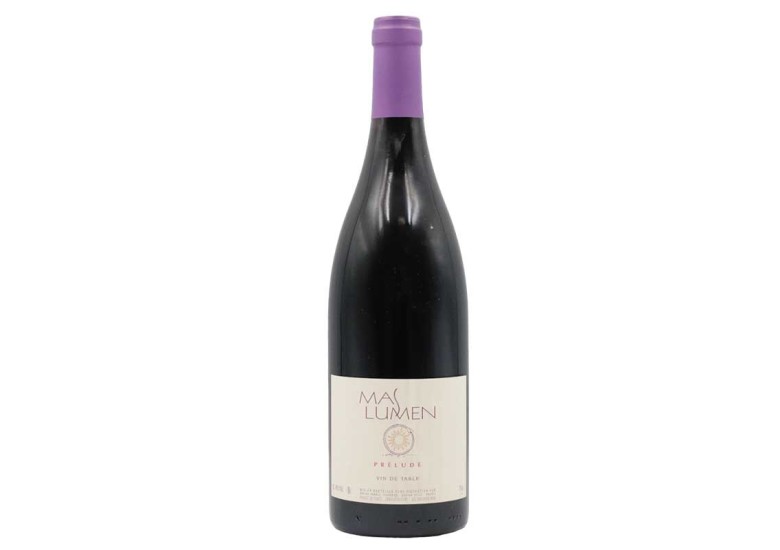- Rupture de stock

Mas Lumen Prelude
2006 Table wine - 75cl
remove_circle Rupture de stock
This 2006 wine, born on a schist terroir, still displays the characteristics of an astonishing youth.
Profil
Red wine at its peak
Grape varieties
Syrah
Cinsault
Carignan
Black Grenache
Perfect pairing
Red meat
To be consumed
3 year guard potential
 A caviste at your disposal
A caviste at your disposal
You need help, do not hesitate to contact us to refine your order and your pleasure
 Politique de livraison
Politique de livraison
(à modifier dans le module "Réassurance")
 Garanties sécurité
Garanties sécurité
(à modifier dans le module "Réassurance")
 Politique retours
Politique retours
(à modifier dans le module "Réassurance")
Mas Lumen
Prélude 2006
Vin de Table
France - Languedoc
![]()
![]()
Grape varieties:
37% syrah, 35% carignan, 20% grenache noir, 8% cinsault
Tasting Notes:
This 2006 wine, born on a schist terroir, still displays the characteristics of an astonishing youth in its black color with brown reflections. Stewed, grilled fruits, spices give character to the nose. Its dense substance on the palate, still a little firm, and its good aromatic persistence announce a blooming reached for our greatest pleasure.
Wine style:
Red wine when ripe.
Food and wine :
Shoulder of hare with porcini mushrooms and morello cherries. Lamb shank confit with sweet spices.
Aging potential in your cellar:
3 years
Analytic :
75 cl - 14% volume
Contains sulfites
Alcohol abuse is dangerous for health. To consume with moderation.
"The consumption of alcoholic drinks during pregnancy, even in small quantities, can have serious consequences on the health of the child".
Fruity
Roundness
Power
Wooded
General information
Brand : Mas Lumen
Reference : Mas-Lumen-Prélude
Appellation : Table wine
Label : Wine without added sulphites
Type of agriculture : Organic Agriculture
Color : Red wine
Profil : Red wine at its peak
Conservation : 3 year guard potential
Grape varieties : Syrah, Cinsault, Carignan, Black Grenache
Region : Languedoc wine
Country : France
A wine to discover or rediscover at your wine merchant
The other vintages of:
Pascal began his professional life by observing nature and enclosing it in his photographic box. Initiation with the greatest photographers, studies of art history, museum guard at the Louvre, he has done everything possible to develop his gaze as well as possible to transmit it through the lens. Many trips to South America and Asia then allowed him to discover new horizons and approach other cultures. In 1989, he collaborated with the Image Bank agency and drew on American professionalism. At the same time, the revelation of a great wine opens up a new world of sensations that he wants to explore. He continues to taste and develop his knowledge of wine and winegrowers. Case in hand, he travels the French vineyards, meets and observes: Jacques Raynaud (in Châteauneuf-du-Pape), his terroir, his old cellar and his unforgettable wine; Coche Dury (in Meursault) so difficult to photograph, its perfectionism, its integrity and whose wine reveals unequaled aromas; Henry Jayer (in Vosne-Romanée), Marcel Guigal (in Ampuis), Didier Daguenneau (in Pouilly / Loire), Didier Barral (in Faugères) and many others.
Little by little, the desire to become a winegrower is essential. He leaves Paris and deploys his energy to search for the terroir of his dreams, while continuing his collaboration with specialized magazines: Wine Spectator, Revue du Vin de France, Gault & Millau… In 1997, during a report on the great winegrowers of Languedoc, he was seduced by the potential of this region, in full restructuring. He looks around Pézenas and sets his sights on Gabian. This Gabian terroir presents, in fact, a variety of schist and basalt soils well suited to the cultivation of quality vines.
Pascal decided to set up his small cellar in 2001. His practice and his analysis of large bottles - which are lacking in so many traditional winegrowers - compensate for a late approach to the vineyard and to winemaking. Pascal is carrying out the restructuring of a cellar in the village of Gabian where he installs, with the perfectionism we recognize in him, efficient vats and vinification equipment. He applies the lessons learned at Pézenas (Professional Agricultural Certificate) and supplemented by the precious advice of his winegrower friends. He pruned short, worked the soil and began to implement his “nature” theories for the management of the vines and respect for the environment. Observation of the winegrowers enabled him to define the methods of vinification and the adequate organization of the winery. Plot-based vinification allows him to master, on his own, the production processes in small containers (stainless steel vats, 5 hectoliters half-barrels). Everything must be impeccable: no leaves, no damaged grapes, not the slightest juice in the bottom of the crates. Slow maceration reveals incredible fruit aromas, fermentation in barrels gives a woody wine structure without excessive aromas.
The flesh, finesse and impeccable fruit of its reds reflect a great rigor in the development of the wines, where the expression of the fresh lands of schist and basalt takes precedence, in the spirit of the best faugères. Its pure terret white wine, a forgotten local grape, is a marvel that slowly evolves in the bottle. Pascal produces “natural” wines with a very strong personality.

Powerful wine, with aromas of kirsch cherries, with good length and spicy finesse.
It is a very beautiful wine which has evolved admirably and proves, today, that great wines were produced in Languedoc in this vintage marked by the heat wave!
New cuvée from Pascal Perret. A fresh and tense wine, aged in 500-liter terracotta amphorae. An already very pleasant wine despite its young age.
Made from terret, it is a very complex wine, with a magnificent evolution.